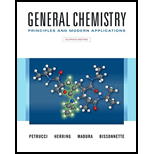
(a)
Interpretation:
The difference between spontaneous and nonspontaneous processes needs to be explained.
Concept introduction:
(b)
Interpretation:
The difference between second and third law of thermodynamics needs to be explained.
Concept introduction:
Thermodynamics is a branch of chemistry that mainly deals with the heat exchange between two systems or between system and surroundings. It also explains the heat content of any system in terms of enthalpy, entropy and Gibb’s free energy. The heat content of a system can be shown in terms of temperature of it which is related to pressure and volume.
(c)
Interpretation:
The difference between
Concept introduction:
Thermodynamic is a branch of chemistry that mainly deals with the heat exchange between two systems or between system and surroundings. It also explains the heat content of any system in terms of enthalpy, entropy and Gibb’s free energy. The heat content of a system can be shown in terms of temperature of it which is related to pressure and volume.
(d)
Interpretation:
The difference between
Concept introduction:
Thermodynamics is a branch of chemistry that mainly deals with the heat exchange between two systems or between system and surroundings. It also explains the heat content of any system in terms of enthalpy, entropy and Gibb’s free energy. The heat content of a system can be shown in terms of temperature of it which is related to pressure and volume.
Want to see the full answer?
Check out a sample textbook solution
Chapter 13 Solutions
Mastering Chemistry With Pearson Etext -- Standalone Access Card -- For General Chemistry: Principles And Modern Applications (11th Edition)
- 2. Which of the following is true for a spontaneous process but not for a nonspontaneous process? Energy in the universe is concentrated conserved dispersed not conservedarrow_forwardAppendix J lists standard molar entropies S, not standard entropies of formation rS. Why is this possible forentropy but not for internal energy, enthalpy, or Gibbsfree energy?arrow_forwardWhat is the sign of the standard Gibbs free-energy change at low temperatures and at high temperatures for the explosive decomposition of TNT? Use your knowledge of TNT and the chemical equation, particularly the phases, to answer this question. (Thermodynamic data for TNT are not in Appendix G.) 2C7H5N3O6(s) 3N2(g) + 5H2O() + 7C(s) + 7CO(g)arrow_forward
- What is the sign of the standard Gibbs free-energy change at low temperatures and at high temperatures for the combustion of acetaldehyde? CH3CHO(l)+52O2(g)2CO2+2H2O(l)arrow_forwardThe synthesis of glucose directly from CO2 and H2O and the synthesis of proteins directly from amino acids are both non-spontaneous processes under standard conditions. Yet it is necessary for these to occur for life to exist. In light of the second law of thermodynamics, how can life exist?arrow_forwardCalculate the standard Gibbs free-energy change when SO3 forms from SO2 and O2 at 298 K. Why is sulfur trioxide an important substance to study? (Hint: What happens when it combines with water?)arrow_forward
- Chemists and engineers who design nuclear power plants have to worry about high-temperature reactions because it is possible for water to decompose. (a) Under what conditions does this reaction occur spontaneously? 2H2O(g) 2H2(g) + O2(g) (b) Under conditions where the decomposition of water is spontaneous, do nuclear engineers have to worry about an oxygen/hydrogen explosion? Justify your answer.arrow_forwardDescribe how the standard entropy of hydrogen gas at 25C can be obtained from heat measurements.arrow_forwardWhat is the sign of the standard Gibbs free-energy change at low temperatures and at high temperatures for the synthesis of ammonia? 3H2(g) + N2(g) 2NH3(g)arrow_forward
- Define the following: a. spontaneous process b. entropy c. positional probability d. system e. surroundings f. universearrow_forwardWhen 1.000 g of ethylene glycol, C2H6O2, is burned at 25C and 1.00 atmosphere pressure, H2O(l) and CO2(g) are formed with the evolution of 19.18 kJ of heat. a Calculate the molar enthalpy of formation of ethylene glycol. (It will be necessary to use data from Appendix C.) b Gf of ethylene glycol is 322.5 kJ/mol. What is G for the combustion of 1 mol ethylene glycol? c What is S for the combustion of 1 mol ethylene glycol?arrow_forwardThe formation of aluminum oxide from its elements is highly exothermic. If 2.70 g Al metal is burned in pure O2 to give A12O3, calculate how much thermal energy is evolved in the process (at constant pressure).arrow_forward

 ChemistryChemistryISBN:9781305957404Author:Steven S. Zumdahl, Susan A. Zumdahl, Donald J. DeCostePublisher:Cengage Learning
ChemistryChemistryISBN:9781305957404Author:Steven S. Zumdahl, Susan A. Zumdahl, Donald J. DeCostePublisher:Cengage Learning Chemistry: An Atoms First ApproachChemistryISBN:9781305079243Author:Steven S. Zumdahl, Susan A. ZumdahlPublisher:Cengage Learning
Chemistry: An Atoms First ApproachChemistryISBN:9781305079243Author:Steven S. Zumdahl, Susan A. ZumdahlPublisher:Cengage Learning Chemistry & Chemical ReactivityChemistryISBN:9781133949640Author:John C. Kotz, Paul M. Treichel, John Townsend, David TreichelPublisher:Cengage Learning
Chemistry & Chemical ReactivityChemistryISBN:9781133949640Author:John C. Kotz, Paul M. Treichel, John Townsend, David TreichelPublisher:Cengage Learning Chemistry: Principles and PracticeChemistryISBN:9780534420123Author:Daniel L. Reger, Scott R. Goode, David W. Ball, Edward MercerPublisher:Cengage Learning
Chemistry: Principles and PracticeChemistryISBN:9780534420123Author:Daniel L. Reger, Scott R. Goode, David W. Ball, Edward MercerPublisher:Cengage Learning Chemistry & Chemical ReactivityChemistryISBN:9781337399074Author:John C. Kotz, Paul M. Treichel, John Townsend, David TreichelPublisher:Cengage Learning
Chemistry & Chemical ReactivityChemistryISBN:9781337399074Author:John C. Kotz, Paul M. Treichel, John Townsend, David TreichelPublisher:Cengage Learning





